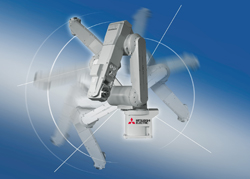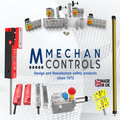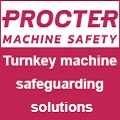
Posted to News on 13th Oct 2006, 16:42
Ten good commercial reasons to use robotics
Barr and Paatz, which has designed and installed many automated systems using cutting-edge Stubli, Mitsubishi and Bosch Rexroth hardware, is suggesting 10 commercially-sound reasons to use industrial robots.

Barr and Paatz, which has designed and installed many automated systems using cutting-edge Stubli, Mitsubishi and Bosch Rexroth hardware, is suggesting 10 commercially-sound reasons to use industrial robots.
Even as global investment in industrial robots surges to record levels, with worldwide orders in 2004 up 20 per cent according to UNECE, the uptake of this technology in the UK continues to lag behind other industrial countries. With an estimated 14,000+ installed units, there are just 40 robots for every 10,000 people employed in the UK manufacturing industry; this compares unfavourably with around 320 per 10,000 employees in Japan, 150 in Germany, 120 in Italy, 100 in Sweden, 80 in the US, even 70 in Spain and France.
Pundits suggest this is because British management must take a much shorter-term view of capital investment to appease shareholders. But robotics and process automation specialist Barr and Paatz points out that the cost of a modern multi-axis industrial robot is on a par with a sales rep's car and it would be revealing to compare the returns on investment. Labour displacement is another reason why British manufacturing might resist robotics, yet Barr and Paatz contends that its impact on job losses is greatly exaggerated.
"Whilst savings on labour content for automated processes is undoubtedly a cost benefit of this technology, in our experience installing industrial robots hardly ever puts people out of work," says Barr and Paatz MD, Stirling Paatz. "Generally it frees them from routine, repetitive tasks and allows them to be redeployed into more appropriate work. Besides, robotics itself is creating new jobs, like technicians, engineers, programmers, supervisors and systems designers."
To encourage British management and production engineers to take a fresh look at this investment opportunity, Barr and Paatz, which has designed and installed many automated systems using cutting-edge Stubli, Mitsubishi and Bosch Rexroth hardware, is suggesting 10 commercially-sound reasons to use industrial robots:
1. Improved Quality
Thanks to their high positioning precision and outstanding repeatability, robots have the ability to consistently produce top-quality products and accurately perform repetitive tasks. They can also be linked to sensors and vision systems to undertake online QA measurement and inspection. Nor will quality suffer if the work is physically demanding, tedious or in a hazardous environment.
2. Higher Throughput
High quality itself translates into increased net output, with less scrap and rejects, and robots can work faster to maximise gross output too. They can operate round-the-clock to raise productivity levels, do not need breaks, weekends off, holidays and sick leave, and work tirelessly without any loss of performance. Hydraulic, electrical and pneumatic drive systems also mean more muscle power than humans, enabling heavier tasks to be performed.
3. Extreme Precision
Extreme positioning precision and repeatability of +/-0.02mm or better means that robots can undertake tasks that could not be accomplished by a human. High precision also means improved visual appearance of the product, with cleaner welds and better finishes, which yields higher perceived quality and premium prices. Moreover a properly maintained robot can give fifteen years of precision work - a near impossible human feat.
4. Enhanced Revenue
Consistent quality, higher productivity, fewer rejects and reduced time to market translate into enhanced revenue opportunities, while extreme precision provides an entr½e into new markets and products. Robots might not be able to do specific tasks faster than human operators, such as welding or machine loading, but they will do them consistently, so managers should consider revenue per operation hours, not just per square foot.
5. Cost Avoidance
In addition to eliminating all or most labour costs on automated processes, robots ensure fewer wasted consumables, like paint and epoxies, less waste disposal expenses and, thanks to improved quality, the removal of downstream corrective rework or rejects. Robots do not have the same ventilation or lighting requirements as humans and they save money on employee-related expenses such as injury compensation, sick pay and liability insurance.
6. Flexible Automation
With new computer control algorithms, vision systems and improved mobility, robots are far more flexible than fixed automation. The trend toward shorter product life cycles has dictated growing flexibility for manufacturing equipment and a robot can be reprogrammed and redeployed any number of times, representing an unbeatable ROI. Emerging technologies also make it possible to use six-axis robots for processes previously the exclusive domain of CNC machines.
7. Employee Benefits
Maintaining a conducive working environment is key to getting the best performance from employees and robots can be used to minimise fatigue and risk of injury. Safety is often a main driver for installing robots, removing people from the presence of heavy machinery, dangerous environments and the risk of handling heavy weights. Robots also substitute for humans on routine or repetitive work and can assist workers to make their jobs more efficient and manageable.
8. Affordable Ownership
With the price of robots falling and their relative performance increasing rapidly, it is estimated that a robot today would cost less than a quarter of one purchased in 1990, with similar functionality. The price of hardware relative to labour costs has fallen as dramatically, while smaller installation footprints, especially for five/six-axis and tabletop robots, mean less expensive floorspace. Moreover, it is estimated the average service life is 15 years, even operating continuously round-the-clock.
9. Rapid Payback
Lower installation costs translate into faster payback. The simple payback formula is total capital investment divided by annual labour cost savings minus robot maintenance. Factor in double shifts or 24/7 operation and payback is obviously quicker - typically within a period of two to four years. Flexible automation and extreme reliability, with well installed robots going over five years between breakdowns, also mean that the same robot can be deployed elsewhere, so the hardware is effectively free, other than programming and maintenance.
10. Maintain Competitiveness
Enhanced quality, minimal rejects, increased throughput, less wastage and reduced manufacturing costs all add up to improved market competitiveness. Goods are cheaper and brought to market quicker, new product development is streamlined, resulting in a stronger competitive stance. Robots can be a cost-effective alternative to moving production overseas and the answer to a shrinking labour supply that is affecting the manufacturing sector. As the saying goes in America, 'automate or evaporate'.
Robotics is a key technology in process automation and should be part of the investment and strategic plans for UK manufacturing companies, believes Barr and Paatz. Furthermore, robot programming, installation and maintenance skills in this country are second-to-none, thanks to go-ahead automation specialists like Barr and Paatz, so there is really no reason to lag behind overseas competitors.
Want the latest machine building news straight to your inbox? Become a MachineBuilding member for free today >>
GLOBAL

















